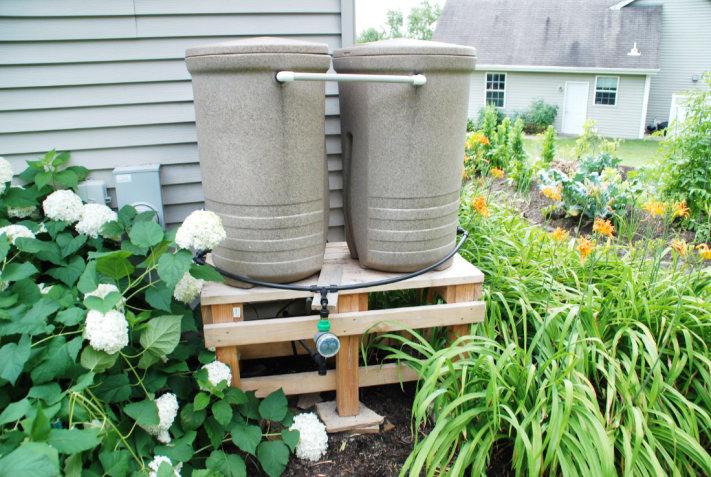
5 minute read
Use rain barrels to capture rainwater
from Harvest 2022
Put rainwater to use in your landscape with the help of rain barrels. This centuries-old technique allows you to capture rainfall to use for watering ornamental gardens and containers.
While some municipalities have restrictions on water harvesting, most encourage this practice. It’s certainly not likely to be an issue in Klickitat County environs. Purchase a rain barrel or make your own from a large, recycled food grade container. In either case, there are some features to consider when purchasing, creating, and adding a rain barrel to your landscape.
Advertisement
Make sure the top is covered to keep out bugs and debris. Some come equipped with a solid lid with an opening just big enough to accommodate the downspout. Others use a screen to keep out debris, while letting in the rain. Don’t worry about mosquitoes breeding inside your rain barrel. Just use an organic mosquito control like Mosquito Dunks and Mosquito Bits in rain barrels and other water features. Mosquito Bits quickly knock down the mosquito larval population, while Mosquito Dunks provide 30 days of control. They are both safe for people, pets, fish, wildlife, and beneficial insects.

Look for one with the spigot near the base of the barrel so water does not stagnate in the bottom. Use the spigot to fill watering cans or attach a hose for watering.
Include an overflow outlet near the top of the barrel to direct excess water away from the house or for connecting adjacent barrels. A downspout diverter is another way to manage rain barrel overflows. When the rain barrels are full, this device diverts the water back to the downspout where it is carried away from your home’s foundation.
Elevate your rain barrel on cement blocks, decorative stands, or similar supports. This provides easier access to the spigot for filling containers and speeds water flow with the help of gravity. A water pump will boost water pressure for a nice steady flow of water.
Dress up your container with a bit of paint suited for outdoor use on plastic surfaces. And don’t worry if you are not an artist, you can hide your rain barrels with some decorative screens or plantings or upright shrubs, perennials or ornamental grasses. Just make sure you have easy access to the spout for retrieving water.

Start your conversion to rain barrels one downspout at a time. You can capture as much as 623 gallons of water from 1,000 square feet of roof in a one-inch rainfall. This can be a lot to manage when first adjusting to this change of habit. Disconnecting one downspout at a time allows you to successfully match the use of rain barrels and other rain harvesting techniques to your gardening style and schedule.
The choices are many, making it easy for you to conserve water and grow a beautiful landscape.


—Melinda Myers
Don’t let limited sunlight stop you from growing a beautiful garden. Make the most of shady locations with proper plant selection and design strategies. Start the season with native spring ephemerals like hepatica, spring beauties and trout lilies. These plants grow and flower early in the season before the trees leaf out, shading the area.
They dieback soon after flowering as shade tolerant plants fill the garden. Look for those native to your region. Select bright and lime green foliage plants that stand out in the shady corners of your landscape. Combine them with your favorite dark leafed and flowered plants that tend to disappear in the Continued page 30
Klickitat County Harvest shade. The contrasting colors help both plants pop.
Use plants with variegated foliage to light up the garden long after their flowers fade. Siberian bugloss (Brunnera) has blue forget-me-not-like flowers in spring and variegated heart shaped leaves. Variegated Solomon Seal’s upright stems covered with green leaves edged in cream, white bell-shaped flowers, and yellow fall color provide interest.
Barrenwort (Epimedium) also
RESPONSIBLE RECYCLING DO DON’T
Stick to the Basics
Curbside pickup:
• Aluminum & tin cans, cardboard, paper, plastic bottles, jugs, & tubs
Drop-off only:
• Appliances, electronics, glass, moderate risk waste, & scrap metal
Recycle these items:
• Shredded paper
• Plastic clamshells (e.g., salad/strawberry containers)
• Plastics (unless bottles, jugs, or tubs)
• Food-contaminated boxes or containers
(such as dirty pizza boxes) provides seasonal color in the shade. The heart shaped leaves are tinged red and emerge with the flowers in spring. The leaves turn green for the summer and then change once again to red in fall.
Add some height to those shady areas with bugbane. The leaves are topped with white spires of flowers in summer or fall, depending on the variety selected.
The white or pink blossoms of Roger’s flower brighten the early summer garden. The big, bold leaves of this moisture-loving perennial resemble those of a horse chestnut tree.
The narrow leaves of sedges and Hakone grass create a striking contrast with the bold leaves of hostas. For an even bolder statement and focal point include a few elephant ears.
Look for shade tolerant plants with a variety of leaf shapes and sizes. The differences in texture
Waste Reduction
Make reducing your waste your first step. How?
• Choose products made from recycled material.
• Purchase items that are reusable. Ditch the disposables and plastics!
• Buy secondhand whenever possible.

• Repurpose items for a new use.
• Repair items to extend their lifecycles.
• Donate useable items instead of throwing them away.
add interest to the shade garden. Repeat the leaf sizes and shapes to unify the garden. Use this same strategy to create continuity between sun and shade gardens in your landscape.
Include a variety of plant shapes. Use columnar plants to create a focal point and weeping and mounded plants for a sense of fluidity in the garden.
A lack of sun is not the only factor to consider when planning a shade garden. The density of the canopy of trees or an overhang may also limit the water that reaches and is available to the plants below. Growing dry, shade-tolerant perennials will help reduce your long-term maintenance. Barrenwort, liriope, coral bells, foam flower, sweet woodruff and hellebores are fairly shade tolerant once established.
Make sure all new plantings are watered thoroughly and when the top few inches of soil are crumbly and moist. Proper watering the first few years will result in deep, drought tolerant root systems that will help these plants grow and flourish despite the dry shade.
To reduce contamination, which affects our recycled material marketability, we have implemented the following:
• Republic Services is tagging bags with noticeable contamination and will not collect them until the contamination is removed.
• Know before you throw! Search the Waste Wizard disposal tool to ensure proper disposal.
When planting under or near trees, be careful not to kill the trees when creating your shade garden. Don’t cut or remove surface roots, creating entryways for insects and diseases. Adding as little as an inch of soil over the roots can kill some tree species. Avoid deep cultivation which can damage the feeder roots that are critical for water and nutrient absorption.
If there’s too much shade to grow even shade-loving plants, consider mulch to protect the soil and tree roots. Add a chair for relaxing and enjoy this cool space as summer temperatures rise.
—Melinda Myers











